
Multi-Action is part of ID Images, a unified collective of award-winning label companies across North America. Learn more at: IDImages.com

Multi-Action is part of ID Images, a unified collective of award-winning label companies across North America. Learn more at: IDImages.com
Knowing how to interpret the information found on food packaging is crucial to our health and safety.
Food labels help us to make good choices. The information found on these labels enables us to detect if a food product is the subject of a recall, if it’s passed its expiration date, and if it’s healthy… or not.
This article will help you better understand the labels on food packaging.
Everyone is used to seeing food labels, but few know how to interpret them!

An in-depth look at the information found on food.

This list names all the ingredients used to make the product by decreasing order of quantity. The main ingredient used to make the product will be listed first, whereas the last ingredient was used in smaller quantities.
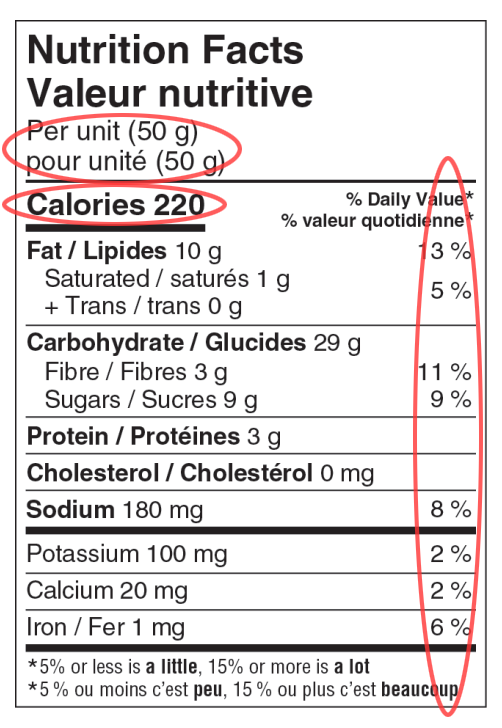
This table helps you make informed choices about your diet. It’s made up of three elements:
The serving size indicates the quantity of food used to calculate the nutritional value. It’s not necessarily the suggested quantity that you should eat. The serving size allows you to:
These amounts are indicated in either grams or milligrams, depending on the food item.
The nutrition facts table lists different nutrients with their percent daily value (% DV). This number represents the percentage of the Daily Value for each nutrient in a single serving.
The following nutrients and their % DV are required to be listed in the nutrition facts table:
How can you tell if a nutrient is present in either a small or large quantity?
Note, however, that it’s not mandatory to list cholesterol’s % DV and the % DV for some vitamins and minerals.
Beware of empty calories!
Even though we need calories to function, some calories, called empty calories, bring very little or no nutritional advantage.
Calories indicate how much energy is contained in the food. Your body needs calories to function. However, if you consume more calories than you burn, you’ll eventually gain weight. If you consume less, you’ll lose weight.
Carbohydrates, fats and proteins provide calories.
The number of calories is calculated according to the serving size. If you were to eat an entire 540ml can of soup, for example, and that the food label indicates 120 calories for 250ml, you’d be eating two serving sizes, and 259 calories.
The following chart lists a person’s recommended daily calorie intake.
Age and Gender
A detailed look into the nutrients found in the nutrition facts table.
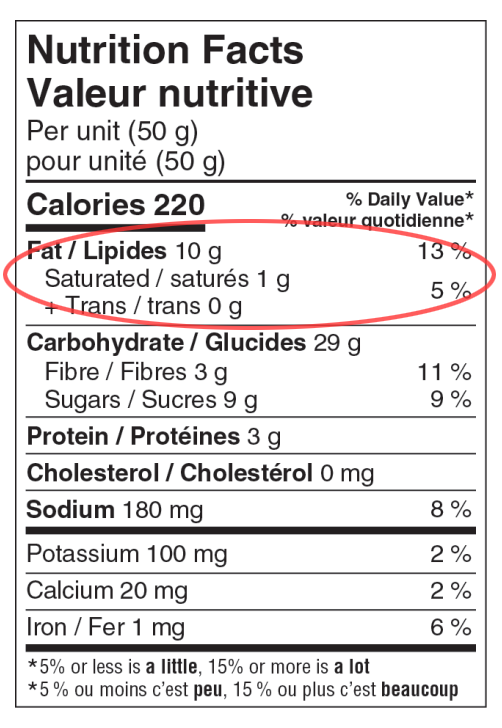
Fats are essential to your health. They provide the body with energy and help support cell growth. Fats also help the body to absorb specific vitamins.
There are 3 types of dietary fats:
Fats and cholesterol are closely linked.
LDL cholesterol (bad cholesterol) can increase the risk of heart disease since a high level of LDL cholesterol facilitates the formation of plaque in blood vessels. The plaque blocks part of the vessels and reduces blood and oxygen flow.
On the other hand, HDL cholesterol (good cholesterol) helps eliminate bad cholesterol from arteries by transporting it to the liver where it is eliminated.
Listed below is the recommended daily intake of dietary fat by percent of total energy.
| Age | Total fats | n-6 polyunsaturated fatty acids (linoleic acid) |
n-3 polyunsaturated fatty acids (α-linolenic acid) |
|---|---|---|---|
| 1-3 years | 30-40 % | 5-10 % | 0.6-1.2 % |
| 4-18 years | 25-35 % | 5-10 % | 0.6-1.2 % |
| 19 years & over | 20-35 % | 5-10 % | 0.6-1.2 % |
Trans fats increase the LDL (bad cholesterol) level in the blood and decrease HDL (good cholesterol) level.
This type of fat is found naturally in:
A small quantity of trans fat is formed when refining certain oils like soy oil and canola oil.
Trans fats are listed under different names in the ingredients:
Reduce your intake of trans fats as much as possible by choosing lean meats and dairy products that are low in fat.
Saturated fats also increase LDL cholesterol levels in the blood. This is because they are saturated with hydrogen atoms, which makes them solid at room temperature.
Saturated fats can be found in:
Reducing your intake of saturated fats and substituting them with low-fat dairy products and lean meats is also advised.
Contrary to trans fats and saturated fats, unsaturated fats are good for your health and help reduce the level of LDL cholesterol in your blood, thus reducing the risk of heart disease.
These fats are composed of fewer hydrogen atoms, which means that they are liquid at room temperature.
There are two types of unsaturated fats:
Oils composed of monounsaturated fat are liquid at room temperature but become solid when refrigerated.
Monounsaturated fats are found in:
Oils made of polyunsaturated fat remain liquid at room temperature and when refrigerated.
They are found in:
Whenever possible, chose foods with unsaturated fats rather than trans or saturated fats.
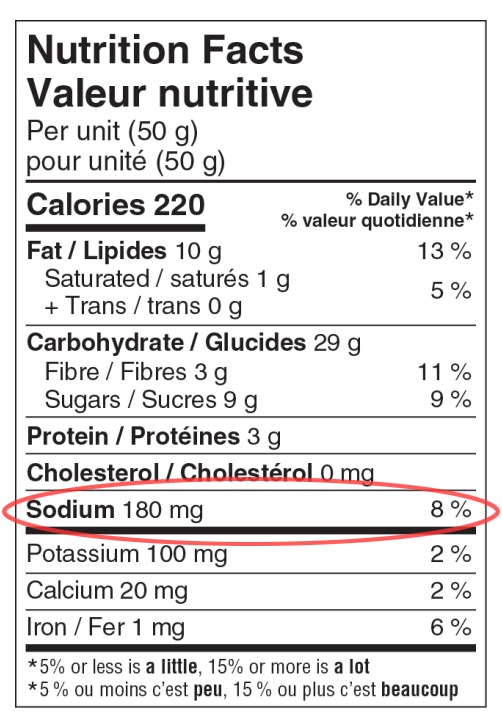
Sodium is generally associated with salt. Salt is made up of 60 % chlorine and 40 % sodium.
Sodium is essential for nerve and muscle function. It maintains blood pressure and balances body fluids. It’s not recommended to consume too much, however.
Overconsumption of sodium can increase the risk of hypertension, diabetes and kidney disease.
The primary sources of sodium in the typical Canadian diet are:
Sea salt, kosher salt and fleur de sel aren’t a healthier alternative when it comes to reducing sodium intake. They all contain almost the same amount of sodium.
Sodium can be found in the ingredient list under these alternate names
“In order to maintain a healthy weight and live with vibrance and vitality throughout our lives, we need to consume as much whole, unprocessed food as possible, reducing processed foods whenever possible. This kind of diet will support healthy hormone balance and overall health.”
– Erin Andersen,
Editor of CanFitPro Magazine
Did you know that an average of 80 % of our sodium intake comes from processed foods and eating out?
Listed below are the daily recommended dietary allowances for sodium according to age.
| Age | Recommended daily intake of sodium |
|---|---|
| 0-6 months | 110 mg |
| 7-12 months | 370 mg |
| 1-3 years | 800 mg |
| 4-8 years | 1000 mg |
| 9-13 years | 1200 mg |
| 14 years and over | 1500 mg |
| Pregnant and lactating women | 1500 mg |
It’s important not to add salt to foods served to children under one year of age.
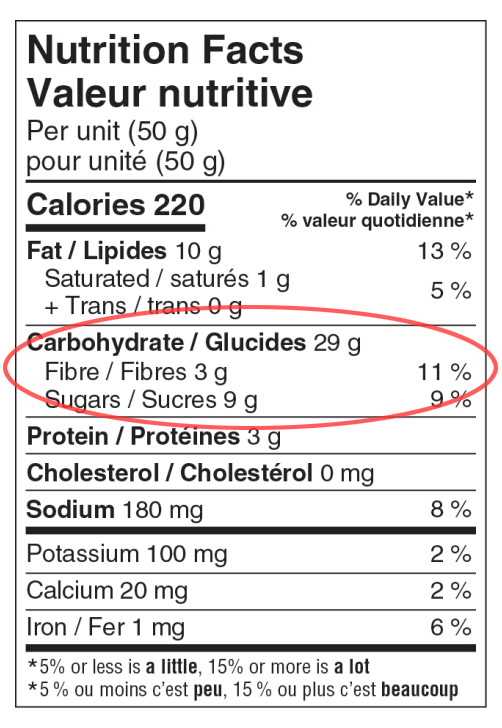
Carbohydrates have a bad reputation, but many are good for your health, particularly those found in fruits and vegetables.
Carbohydrates are divided into three categories:
Fiber is an essential part of a healthy diet. They help decrease cholesterol levels, fight constipation and make you feel full longer.
A minimum of 26 grams of fiber per day is recommended per adult. *
Fiber is found mainly in:
Starches are a form of dietary fibre. You can find them in:
*For exact dietary allowances, please visit Health Canada.
“Carbohydrates should make up 25-55 percent of the total daily caloric intake. Since it is very easy to over-consume this macronutrient, most individuals need to be conscious of carbohydrate consumption in order to regulate their body weight.”
Generally speaking, words ending in “ose” are sugars.
Rosie Schwartz, RD, FDC, dietitian and author, specified that in Canada, nutrition labels aren’t required to specify the quantity of added sugars. As a result, consumers can’t determine how much sugar found in a product is naturally occurring or has been added.
Natural sugars are found in fruit, milk and even some vegetables. Unfortunately, sugars are added to many premade foods to make them more appealing to the palate, even foods that you wouldn’t expect, such as spaghetti sauce and vegetable juices.
Too much sugar can cause cavities and caloric excess. Too many calories can cause obesity which can, in turn, increase the risk of type 2 diabetes, heart disease and some forms of cancer.
Sugar can be found under many names, including:
Listed below are the recommended daily dietary allowances for carbohydrates.
| Age | Recommended daily intake of carbohydrates |
|---|---|
| 0-6 months | 60 g |
| 7-12 months | 95 g |
| 1 year and older | 130 g |
| Pregnant women between 14 and 50 | 175 g |
| Lactating women between 14 and 50 | 210 g |
Carbohydrates like fruit, vegetables, whole grains, beans, peas, lentils and unsweetened dairy products should be our main source of carbohydrates. Avoiding products with added sugars is key.
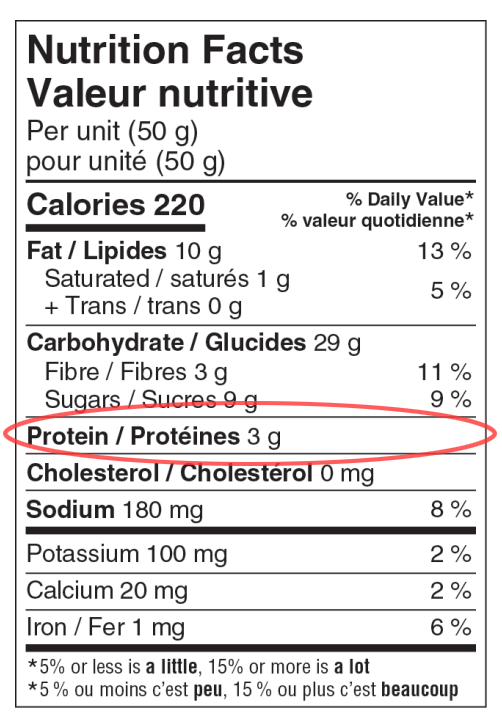
Protein is important in the maintenance of a healthy lifestyle. Protein is a source of energy and helps build and repair body tissues.
Opt for lean meats, fish and legumes when acquiring your daily sources of protein.
Protein is found in the following foods:
Since most people consume enough protein every day, there is no % DV of protein.
Listed below are the recommended daily dietary allowances for protein.
| Age | Recommended daily intake of protein |
|---|---|
| 0-6 months | 9.1 g |
| 7-12 months | 11 g |
| 1-3 years | 13 g |
| 4-8 years | 19 g |
| 9-13 years | 34 g |
| Girls 14-18 years | 46 g |
| Boys 14-18 years | 52 g |
| Women 19 years and over | 46 g |
| Men 19 years and over | 56 g |
| Pregnant and lactating women | 71 g |
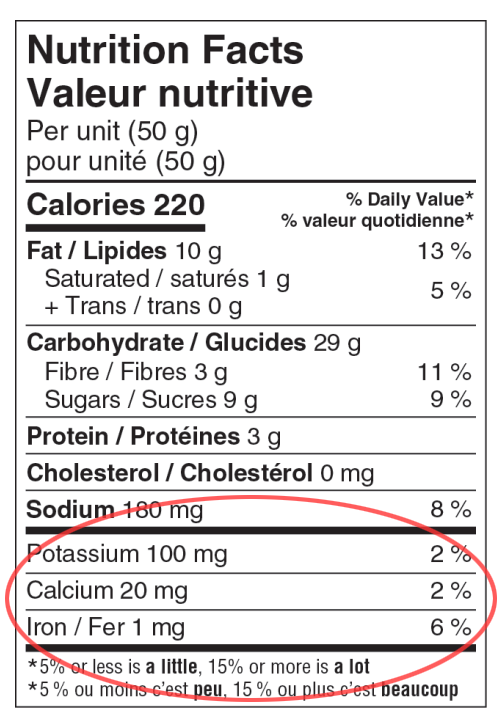
Minerals are essential for our well-being. Minerals are used to keep your bones, muscles, brain and heart functioning properly. They’re also used for making enzymes and hormones.
We’ll take a closer look at the following minerals:
“The most effective way to get a wide variety of vitamins and minerals is to eat a healthy and varied diet. A diet rich in fresh produce that represents a rainbow of colour helps keep deficiencies at bay.”
Potassium is a mineral essential to muscle contraction and the transmission of nerve impulses. It also helps maintain proper liver functions.
A minimum of 4700 milligrams of potassium per day is recommended for an adult. *
Potassium is found in:
Calcium is an essential mineral that contributes to good muscle and nerve function, and the health of bones and teeth.
A minimum of 1000 milligrams of calcium per day is recommended for the average adult. *
Calcium is found in many healthy foods, including:
Iron is a vital mineral that plays two significant roles: Transporting oxygen throughout the entire body and producing red blood cells.
Women have a particularly high need for iron due to their menstrual cycles. A minimum of 18 mg of iron is recommended for women, compared to the 8 mg recommended for men. *
In the nutrition facts table, the iron listed includes heme iron and non-heme iron.
Heme iron is more easily absorbed by the body and is found in:
Non-heme iron is better absorbed by the body when ingested with foods rich in vitamin C.
You will find non-hemic iron in:
*For exact dietary allowances, please visit Health Canada.
Lot codes and dates are printed on products to ensure your health and safety.

Manufacturers affix a unique lot code to each lot of food products. This numeric code indicates when and where the product was made. It allows manufacturers to track their products if a recall is made. It also allows consumers to determine if they’ve purchased a product that’s subject to a recall.

The lot code can be found just about anywhere on the product’s packaging. Because it changes with every lot, it’s either stamped, applied by inkjet or printed on a sticker. It isn’t printed in the same way as the other information found on the label.
If you purchased a product that’s the subject of a recall, throw it away or bring it back to the store. Throw away anything that was made with that food item, whether it’s for consumption or not.
To determine whether a product you’ve purchased is the subject of a recall, consult the Government of Canada website.
Depending on the product, you’ll find expressions such as “Best before” or “Expiration date’’. Unfortunately, many wrongly believe that these dates have the same meaning. So how should you interpret each of these dates?
This date must appear on the following products:
Once the expiration date is passed, the product may not have the same nutritional content as declared on the label, and thus, should be thrown away.
Products can be bought and eaten even after their “Best before” date has passed. This date isn’t an indication that the food is no longer safe for consumption.
The “Best before” date indicates until when an unopened food product that is stored in appropriate conditions will keep its:
Products with an anticipated shelf life greater than 90 days, like canned goods, frozen foods and most dry foods like pasta, aren’t required to indicate their “Best before” date.
Once the “Best before” date has passed, the product may lose some of its taste, freshness and nutritional value. Once the packaging is opened, the “Best before” date doesn’t apply anymore. At that moment, any food that is likely to spoil must be stored according to the indications and eaten as quickly as possible.
Lot codes tell you whether a food is the subject of a recall.
Dates found on the packaging indicate until when a product retains its taste and nutritional value.
The nutrition facts table helps you make good dietary choices. That table, combined with the Canadian food guide and an exercise program adapted to your circumstances, result in a healthy and balanced diet and lifestyle.
“It is important to understand that there is no “one size fits all” approach to nutrition and exercise, but rather individual and unique strategies to make proper nutrition and exercise accessible, achievable, and sustainable. Taking small, meaningful steps will lead to lasting success, both short and long term, rather than aiming for perfection when it comes to eating and exercise habits.”
– Erin Andersen,
Editor of CanFitPro Magazine
*All daily dietary allowances charts shown in this article come from Health Canada and are valid in Canada.